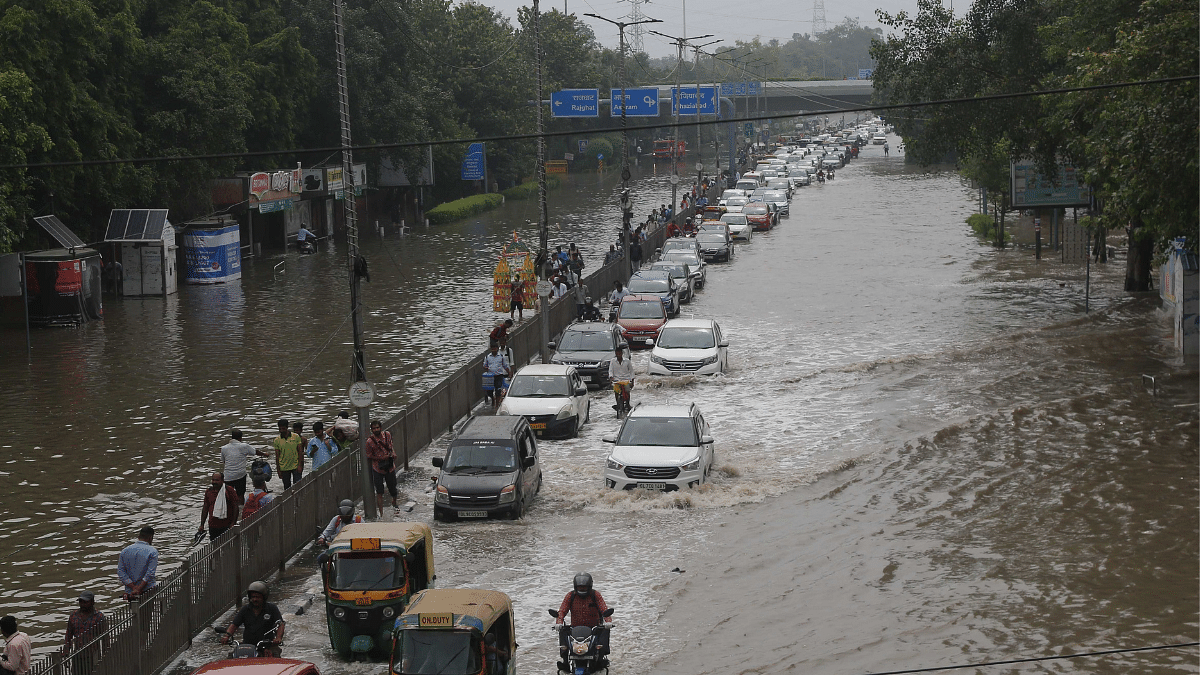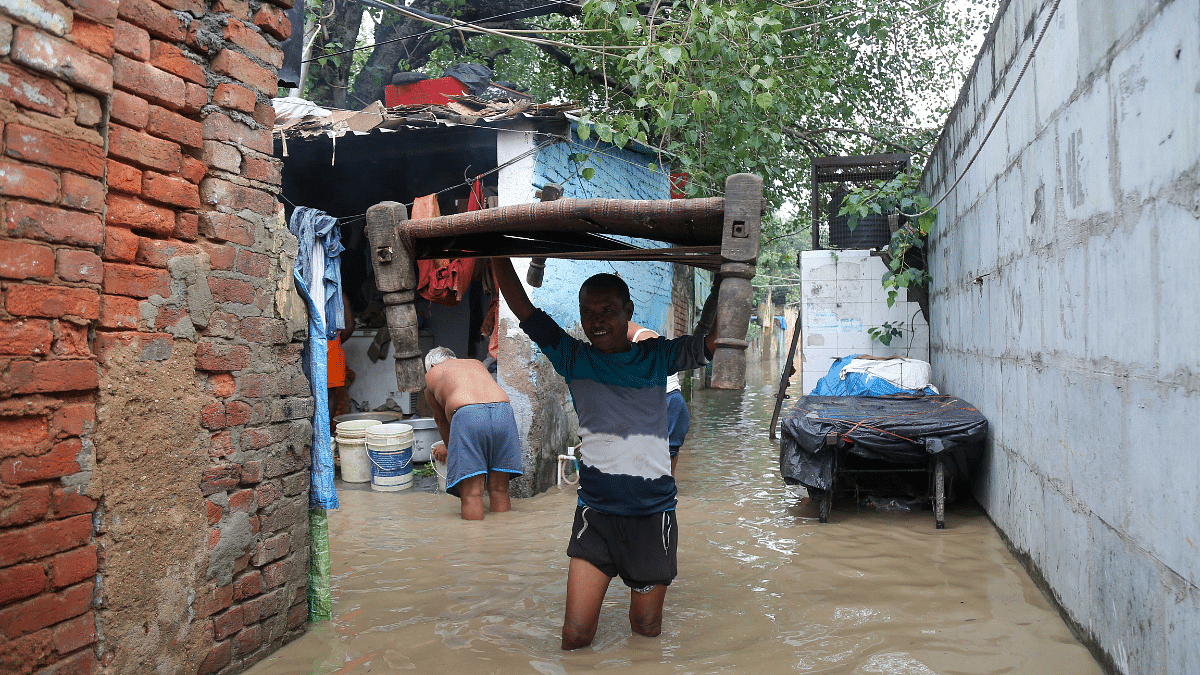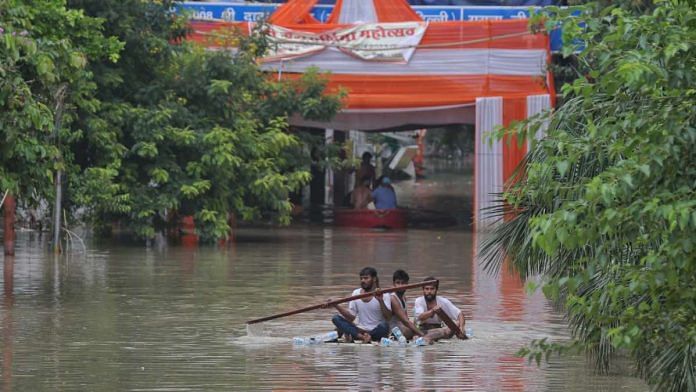New Delhi: A month after large parts of the capital were inundated in the wake of heavy rainfall and the Yamuna rose to an all-time high of 208.6 metre — breaching the danger mark and a 45-year record — the Centre and Delhi government have constituted two separate committees to look into the reasons behind the flooding and suggest preventive measures.
While the central government committee will conduct a flood management study of the Yamuna and its reaches between the Hathnikund Barrage in Haryana and the Okhla Barrage in Delhi, as well as look into the possibility of decommissioning the ITO Barrage in the Capital, the Delhi government committee will probe the reasons behind the flooding.
A parliamentary standing committee on water resources is also looking into the same issue.
The ITO Barrage, which is maintained by Haryana and whose sluice gates were found jammed during the deluge, was at the centre of the blame game between the AAP-led Delhi government and the BJP-led Haryana government in the wake of the floods.
Triggered by heavy rainfall, the floods were reported to be a result of several other factors as well — heavy discharge of water from the Hathnikund Barrage (which lies in Yamuna’s upper-catchment), absence of adequate drainage infrastructure and encroachments on the Yamuna floodplains.
The affected areas included upscale neighbourhoods like Civil Lines, slum clusters of Yamuna Pushta, the Red Fort, Rajghat, and busy commercial zones on Ring Road and ITO.
As the two committees get down to work and come up with another set of recommendations, the flooding of central locations like ITO and the Red Fort should sound alarm bells for the capital’s multiple agencies to get out of their silos and ensure that Delhi is better prepared to handle such exigencies.
There is a reason for urgency. According to environment expert Bhim Singh Rawat, associate coordinator with South Asia Network on Dams, Rivers and People (SANDRP), since 13 July, Yamuna’s water level has breached the danger mark (205.33 metre) six times.
This level, Rawat said, was never breached earlier when 7-8 lakh cusecs of water was released from the Hathnikund Barrage, say in 2013 and 2019.
“But now, the danger mark is getting breached even when 78,000 cusecs of water is released, like on 16 August. This needs to be investigated,” Rawat told ThePrint.
Frequent breach of Yamuna’s danger mark is just one of the issues. A more critical problem facing the civic agencies is how to fix Delhi’s decrepit drainage network, which is still functioning on a 1976 master plan and has not seen any major upgradation in the past few decades.
Environment and urban planning experts told ThePrint that poor drainage was one of the many reasons behind the floods and an overhaul of the city’s age-old drainage system was urgently required.
The Indian Institute of Technology (IIT) in Delhi had made a new ‘drainage master plan’ for the city and submitted it to the government in 2018, but it was reportedly dismissed.
The Delhi floods have also exposed how multiple agencies — whether in Delhi or Haryana — faltered in maintaining infrastructure to address floods, the most glaring example being the jammed sluice gates of ITO Barrage.
On 15 July, two days after the Yamuna rose to 208.6 metres in Delhi, the Haryana government also formed a high-level committee to look into the floods, which submitted its report on 26 July.
According to a senior officer from Haryana’s irrigation and water resources department, who had accessed the report, the committee pointed to encroachment on the floodplain up to ITO as one of the main reasons for flooding on the Ring Road.

The same was pointed out by Lieutenant Governor V.K. Saxena in a letter to Delhi chief minister Arvind Kejriwal on 17 August. He listed the desilting of drains and dumping of debris on the Yamuna floodplains among factors that had obstructed the flow of the Yamuna.
Also Read: In the same boat, yet not — surviving the Delhi floods, a tale of two localities
Decommissioning ITO Barrage
The central government’s committee, constituted on 6 August and headed by chairman of the Central Water Commission (CWC) Kushvinder Vohra, will look into the possibility of decommissioning the ITO Barrage.
Vohra told ThePrint: “The committee’s mandate is to conduct a joint flood management study of the Yamuna river for its reaches between Hathnikund and Okhla barrages.”
“The panel will look into aspects such as height of bunds (embankment) constructed along the river, meteorological factors, discharging capacity of barrages and functional requirement of the ITO barrage. It will submit an interim report within two months,” he said, adding that the final report will be submitted within six months.
The committee will comprise members from the Haryana, Uttar Pradesh and Delhi governments as well as experts, including officials from National Remote Sensing Centre in Hyderabad, one of the primary units of the Indian Space Research Organisation (ISRO), said Vohra.
The Delhi administration, too, is making efforts to prevent a July-like flood situation in the future, government officials said.
On 9 August, the Delhi government constituted a five-member committee comprising three former chief engineers of the irrigation and flood control department, to assess the reasons behind the flooding.
“The committee will look into the reasons for flooding in north Delhi, including Rajghat, which was unusual. We are also exploring the possibility of raising the bunds along the river, which currently have a minimum height of 208 metre,” a Delhi government official told ThePrint, adding that the panel will submit its report in three weeks.
A parliamentary standing committee on water resources, headed by BJP MP Parbatbhai Savabhai Patel, is also looking into the same issue.
“Members of the parliamentary committee visited Haryana on 8 August to review the situation and will inspect the ITO and Okhla barrages in Delhi on 23 August,” the Haryana government official mentioned earlier said.
Is the ITO Barrage needed?
There are three barrages on the Yamuna after it enters Delhi — in Wazirabad, Okhla and ITO.
The ITO barrage was built by the Punjab government in the 1960s — when Haryana was still part of Punjab — to provide water to two thermal units of Indraprastha Power Generation Company. The water served as a coolant for the turbines. However, the thermal power plant was shut in the 2000s following an order of the National Green Tribunal.
The ITO barrage has 32 gates which are opened whenever there is heavy flow of flood water and water is discharged through them.
In the wake of the floods in Delhi, five sluice gates of the barrage were found jammed as they were clogged with heavy silt and sewage at the bottom.
Personnel from the Indian Army and Navy were called in to open the gates. While two were opened immediately, all five gates were reportedly opened last week.
In its report, the Haryana committee held engineers of the Haryana irrigation and water resources department — who were tasked with maintaining the ITO Barrage — responsible for not following standard operating procedures and practices.
“Based on the committee’s findings, the Haryana government charge-sheeted four department officials, including one who was suspended,” the Haryana government official told ThePrint.
“The high-level committee noted that no meeting was conducted by the chief engineer before the monsoon to review the status of flood management and no attention seemed to have been paid to the ITO Barrage, which is of importance due to its location,” the official added.
However, environment experts have questioned the importance of the ITO Barrage.
Himanshu Thakkar, coordinator at SANDRP, told ThePrint: “The barrage serves no purpose as the thermal plant is no longer operational. It should be decommissioned after proper assessment.”
Environment expert Manu Bhatnagar, principal director at the non-profit INTACH, reiterated the view. “The barrage should have been decommissioned long ago. This was suggested to the previous Delhi Lieutenant Governor by INTACH,” he said.
The central government committee is now looking into the matter. “There is a need to assess the barrage’s functional use. The committee will look into this aspect,” a central government official said.
State of the Yamuna & floodplain
A myriad of seemingly disparate issues contributed to Delhi’s drainage disaster in July this year, according to the report of the Haryana committee.
The panel pointed to encroachment of the Yamuna floodplain up to ITO as one of the main reasons behind flooding on the Ring Road, the Haryana government official said.

Firstly, a grave mistake was committed considering Delhi’s floodplains as an “empty lot”, a belief that allowed for the natural flood outlets of Yamuna to be systematically encroached upon over the decades. As a result, the flow of the Yamuna is being impeded by excessive and unplanned construction in and around the river, the committee stated.
Secondly, during the dry season, the flow of the river upstream of Wazirabad Barrage is almost completely stopped leading to sedimentation and growth of vegetation, it noted.
Thirdly, discharge of polluted water into the river through various drains leads to siltation and causes a rise in the bed of the river. The (jamming) of the five (ITO barrage) gates in the absence of regular desilting exacerbated the issue, according to the committee.
“The committee has recommended that Delhi should be requested to remove the ‘sandy bela’ island in front of gates 28 to 32 so that these gates get flood water flow,” the Haryana official told ThePrint.
In his letter to the Delhi CM, the L-G also noted that of the 44 kilometres of the Yamuna in Delhi, the 22 km stretch from Wazirabad to Okhla had 18 major obstructions, which hindered the flow of water.
The L-G further said that Delhi government departments were indulging in the “unprofessional practice” of not clearing construction and demolition waste, as well as other waste from sites where work on bridges was being executed, and this further obstructed the flow of the river.
The “man-made” obstructions, the L-G further noted, had reduced the velocity of water in the Yamuna, and subsequently resulted in increased water levels that remained within the city limits for an additional “six hours”.
According to environment experts, there is need for a detailed assessment of the river stretch between Hathnikund and Okhla barrages, especially in the Delhi stretch.
Bhatnagar, however, pointed out that flooding of north Delhi and areas such as Rajghat and Red Fort was unusual and couldn’t be blamed on encroachment.
“There is a need to assess the problem. Encroachment on the floodplain can’t be the reason, as no encroachment has taken place in the past few years. In fact, the Millennium Bus Depot was removed from the floodplain,” he told ThePrint.
“Temporary (kacha) roads constructed across the river and near Barapullah Phase-3 flyover could have obstructed the flow of water, resulting in accumulation upstream of the ITO barrage. There is also a need to check the riverbed level,” he added.
Also Read: ‘Tired of rebuilding home’: In relief camps, Delhi’s flood-displaced forced to relive 1978 horror
Backflow from drains
For flooding in Rajghat and Civil Lines areas, Delhi government officials have also pointed to backflow of drains, which often carry untreated sewage water.
Last month, senior officials from Delhi’s flood and irrigation department had told ThePrint that when the level of the Yamuna rose, around one to three lakh cusecs of water was discharged from the Hathnikund Barrage to Delhi on 12 July for most part of the day, with a peak discharge of 3.59 lakh cusecs at 11 am.
Subsequently, backflow of drain water resulted in flooding in large parts of low-lying areas of north Delhi such as Model Town, Civil Lines and Rajghat, they said.
A senior official with the Central Public Works Department (CPWD), who was involved in clearing the water at Rajghat and nearby places, said: “River water didn’t enter the Rajghat area as the bund is very high. The area got inundated due to backflow of drain water. It took us almost a week to clear it.”
A second Delhi government official said that with the highest flood level now standing at 208.66 metres, the level of water flow regulators (structures near the river used to ensure there’s no backflow of water into the city) needed to be changed in terms of height.
When asked why the Yamuna was hitting the danger mark on release of just 78,000 cusecs of water from the Hathnikund Barrage, the official said: “We have to analyse the overall data of water released.”
“Inter-departmental discussions are also taking place to figure out the right mechanism for drainage. Institutional and technical solutions will need to be looked into and a decision cannot be arrived at overnight,” he added.
Drainage plan in the making
Delhi’s age-old drainage system includes natural drains and some that were constructed over a period of time post-Independence.
But the last major drainage infrastructure upgrade happened after 1976, according to officials in the Delhi irrigation and flood control department.
“No major infrastructure development work has taken place in the past two-three decades to improve drainage. In the 1980s, a supplementary drain which is 34-km in length as well as other drains were constructed based on the drainage master plan of 1976,” a department official said.
According to the drainage master plan prepared by IIT Delhi, the city has a total of 426.55 km of natural drainage lines and 3,311.54 km of engineered storm water drains, with 11 different agencies, including the Uttar Pradesh irrigation department, maintaining them.
The IIT plan further divides the Capital’s drains into three major drainage basins: the Najafgarh basin that consists of 123 drains, the Barapullah basin with 44 drains and the Trans-Yamuna basin with 34 drains.
The 57.4-km Najafgarh drain, once called the Sahibi river, is the biggest drain in the national capital that caters to nearly two-thirds of the city.
Regarding maintenance of storm water drains, the IIT plan recommends prevention of construction — such as metro pillars — inside storm water drains, no encroachment and zero discharge of sewage into the drains.
A.K. Gosain, professor emeritus at IIT-Delhi, who headed the team that prepared the drainage master plan, told ThePrint: “There isn’t much space to build new drains in the city, but we have recommended a host of measures through which the drainage problem, which has become a serious concern, can be addressed.”
“Regular desilting of drains, removing encroachment, creating rainwater storage facilities etc, can help address the problem. We also recommended that parks can be a good space to recharge groundwater,” he added.
However, a technical committee of the Delhi government in 2021 reportedly recommended that the IIT drainage plan be rejected over limitations in the data.
The government is now getting a new drainage plan made for the city.
In June this year, a consultant was hired for the Najafgarh basin while bids have been floated to hire consultants for the other two basins, according to government officials.
A third senior Delhi government official told ThePrint: “The government has proceeded from where the IIT plan ended, and may implement some general recommendations made in it.”
The Delhi PWD has been made the nodal agency for the implementation of the new drainage plan.
The government official said that a survey of the city drainage network will also be conducted before the plan is made.
“The survey will be based on the topography and factors such as capacity of water bodies, including in scenarios where there is rainfall. Based on the findings, local and global solutions will be recommended,” he explained.
While the Delhi government is working on the drainage master plan, environment and water experts suggest the concept of “sponge city” — a new urban construction model for flood management which involves developing abundant natural areas, water bodies and forests to absorb rain water and prevent flooding.
SANDRP’s Thakkar said: “In China, Germany etc, work is being done on the concept of sponge cities. The idea is to capture the optimum quantity of rainwater and store it for later use. This in turn reduces the flood discharge into the rivers.”
“The more we will be able to hold rainwater in catchment areas and recharge groundwater, the less incidents of flooding will be reported,” he added.
(Edited by Nida Fatima Siddiqui)



